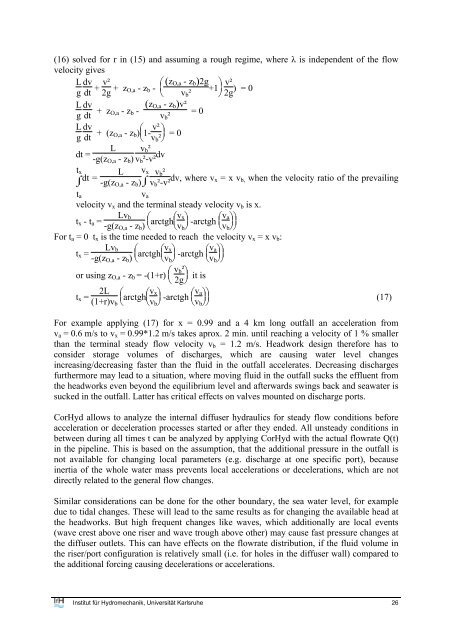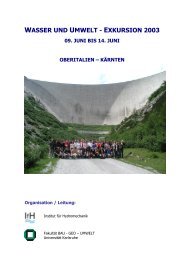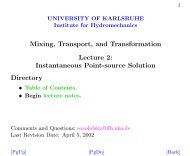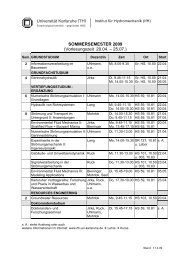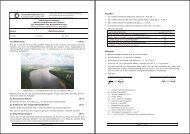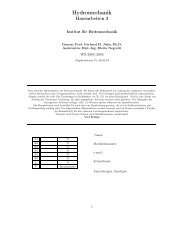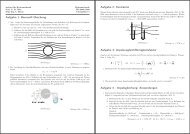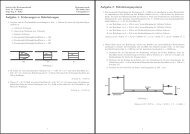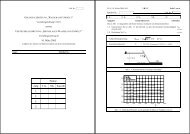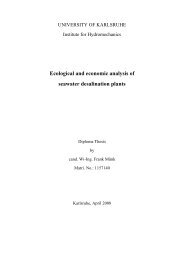user's manual for corhyd: an internal diffuser hydraulics model - IfH
user's manual for corhyd: an internal diffuser hydraulics model - IfH
user's manual for corhyd: an internal diffuser hydraulics model - IfH
Create successful ePaper yourself
Turn your PDF publications into a flip-book with our unique Google optimized e-Paper software.
(16) solved <strong>for</strong> r in (15) <strong>an</strong>d assuming a rough regime, where λ is independent of the flow<br />
velocity gives<br />
L dv<br />
g dt + v²<br />
2g + z O,a - z b - ⎜ ⎛ ( z O,a - z ) b 2g<br />
⎝ v ⎠ ⎟⎞<br />
b ²<br />
+1 v²<br />
2g ) = 0<br />
L dv<br />
g dt<br />
+ z O,a - z b - ( z O,a - z ) b v²<br />
v b ²<br />
= 0<br />
L dv<br />
g dt<br />
+ (z O,a - z b ) ⎜ ⎛ 1- v²<br />
⎝ v ⎠ ⎟⎞<br />
b ²<br />
= 0<br />
L v b ²<br />
dt =<br />
-g(z O,a - z b ) v b ²-v² dv<br />
t xdt L v x v b ²<br />
=<br />
⌡⌠ -g(z O,a - z b )⌡ ⌠ v b ²-v² dv, where v x = x v b, when the velocity ratio of the prevailing<br />
t a<br />
v a<br />
velocity v x <strong>an</strong>d the terminal steady velocity v b is x.<br />
Lv b<br />
t x - t a =<br />
-g(z O,a - z b ) ⎝ ⎜⎛ arctgh⎜ ⎛ v x<br />
⎠ ⎟⎞<br />
⎝ v ⎠ ⎟⎞ -arctgh ⎜ ⎛ v a<br />
b ⎝ v ⎠ ⎟⎞<br />
b<br />
For t a = 0 t x is the time needed to reach the velocity v x = x v b :<br />
Lv b<br />
t x =<br />
-g(z O,a - z b ) ⎝ ⎜⎛ arctgh⎜ ⎛ v x<br />
⎠ ⎟⎞<br />
⎝ v ⎠ ⎟⎞ -arctgh ⎜ ⎛ v a<br />
b ⎝ v ⎠ ⎟⎞<br />
b<br />
or using z O,a - z b = -(1+r) ⎜ ⎛ v b ²<br />
⎝ 2g⎠ ⎟⎞ it is<br />
2L<br />
t x =<br />
(1+r)v b ⎝ ⎜⎛ arctgh⎜ ⎛ v x<br />
⎠ ⎟⎞<br />
⎝ v ⎠ ⎟⎞ -arctgh ⎜ ⎛ v a<br />
b ⎝ v ⎠ ⎟⎞<br />
(17)<br />
b<br />
For example applying (17) <strong>for</strong> x = 0.99 <strong>an</strong>d a 4 km long outfall <strong>an</strong> acceleration from<br />
v a = 0.6 m/s to v x = 0.99*1.2 m/s takes aprox. 2 min. until reaching a velocity of 1 % smaller<br />
th<strong>an</strong> the terminal steady flow velocity v b = 1.2 m/s. Headwork design there<strong>for</strong>e has to<br />
consider storage volumes of discharges, which are causing water level ch<strong>an</strong>ges<br />
increasing/decreasing faster th<strong>an</strong> the fluid in the outfall accelerates. Decreasing discharges<br />
furthermore may lead to a situation, where moving fluid in the outfall sucks the effluent from<br />
the headworks even beyond the equilibrium level <strong>an</strong>d afterwards swings back <strong>an</strong>d seawater is<br />
sucked in the outfall. Latter has critical effects on valves mounted on discharge ports.<br />
CorHyd allows to <strong>an</strong>alyze the <strong>internal</strong> <strong>diffuser</strong> <strong>hydraulics</strong> <strong>for</strong> steady flow conditions be<strong>for</strong>e<br />
acceleration or deceleration processes started or after they ended. All unsteady conditions in<br />
between during all times t c<strong>an</strong> be <strong>an</strong>alyzed by applying CorHyd with the actual flowrate Q(t)<br />
in the pipeline. This is based on the assumption, that the additional pressure in the outfall is<br />
not available <strong>for</strong> ch<strong>an</strong>ging local parameters (e.g. discharge at one specific port), because<br />
inertia of the whole water mass prevents local accelerations or decelerations, which are not<br />
directly related to the general flow ch<strong>an</strong>ges.<br />
Similar considerations c<strong>an</strong> be done <strong>for</strong> the other boundary, the sea water level, <strong>for</strong> example<br />
due to tidal ch<strong>an</strong>ges. These will lead to the same results as <strong>for</strong> ch<strong>an</strong>ging the available head at<br />
the headworks. But high frequent ch<strong>an</strong>ges like waves, which additionally are local events<br />
(wave crest above one riser <strong>an</strong>d wave trough above other) may cause fast pressure ch<strong>an</strong>ges at<br />
the <strong>diffuser</strong> outlets. This c<strong>an</strong> have effects on the flowrate distribution, if the fluid volume in<br />
the riser/port configuration is relatively small (i.e. <strong>for</strong> holes in the <strong>diffuser</strong> wall) compared to<br />
the additional <strong>for</strong>cing causing decelerations or accelerations.<br />
Institut für Hydromech<strong>an</strong>ik, Universität Karlsruhe 26


